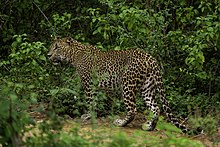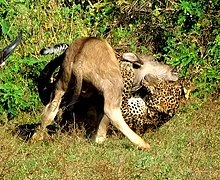Sri Lankan leopard
| Sri Lankan leopard | |
|---|---|

| |
| Sri Lankan leopard in Yala National Park | |
| Scientific classification | |
| Domain: | Eukaryota |
| Kingdom: | Animalia |
| Phylum: | Chordata |
| Class: | Mammalia |
| Order: | Carnivora |
| Suborder: | Feliformia |
| Family: | Felidae |
| Subfamily: | Pantherinae |
| Genus: | Panthera |
| Species: | |
| Subspecies: | P. p. kotiya
|
| Trinomial name | |
| Panthera pardus kotiya Deraniyagala, 1956
| |
The Sri Lankan leopard (Panthera pardus kotiya) is a leopard subspecies native to Sri Lanka. It was first described in 1956 by Sri Lankan zoologist Paules Edward Pieris Deraniyagala.[2]
Since 2020, the Sri Lankan leopard has been listed as Vulnerable on the IUCN Red List, as the population is estimated at less than 800 mature individuals, and is probably declining.[1]
Characteristics
[edit]
The Sri Lankan leopard has a tawny or rusty yellow coat with dark spots and close-set rosettes. Seven females measured in the early 20th century averaged a weight of 64 lb (29 kg) and had a mean head-to-body-length of 1.04 m (3 ft 5 in) with a 77.5 cm (2 ft 6.5 in) long tail, the largest being 1.14 m (3 ft 9 in) with a 84 cm (2 ft 9 in) long tail; 11 males averaged 56 kg (124 lb), the largest being 77 kg (170 lb), and measured 1.27 m (4 ft 2 in) with a 86 cm (2 ft 10 in) long tail, the largest being 1.42 m (4 ft 8 in) with a 97 cm (3 ft 2 in) long tail.[3] The Sri Lankan leopard has possibly evolved to become a rather large leopard subspecies, because it is the apex predator in the country. Large males have been suggested to reach almost 100 kg (220 lb), but evidence for this is lacking.[4]
Melanistic leopards are rare. Few records exist, including from Mawuldeniya, Pitadeniya, and Nallathanniya.[5] In October 2019, the Department of Wildlife Conservation recorded live footage of a melanistic individual for the first time, a male.[6]
Distribution and habitat
[edit]The Sri Lankan leopard is still found in all habitats throughout the island in both protected and unprotected areas.[7] These habitat types can be broadly categorised into:[8]
- Arid zone with <1,000 mm (39 in) rainfall
- Dry zone with 1,000–2,000 mm (39–79 in) rainfall
- Wet zone with >2,000 mm (79 in) rainfall
In Sri Lanka's central hills, leopards have been recorded in forest patches, tea estates, grasslands, home gardens, and pine and eucalyptus plantations.[9]
Ecology and behaviour
[edit]
In Yala National Park, the Sri Lankan leopard as in other locations, is a solitary hunter, with the exception of females with young. Male's ranges typically overlap the smaller ranges of several females, as well as portions of the ranges of neighboring males, although exclusive core areas are apparent. They are more active and prefer hunting at night, but are also somewhat active during dawn, dusk, and daytime hours. They do not usually store their kills in trees, perhaps because similarly-sized or larger carnivores are absent in Sri Lanka. In 2001 to 2002, adult resident leopard density was estimated at 12.1 mature individuals and 21.7 individuals of all ages per 100 km2 (39 sq mi) in Block I of Yala National Park.[10]
The Sri Lankan leopard hunts by silently stalking its prey, until it is within striking distance, when it unleashes a burst of speed to quickly pursue and pounce on its victim. The prey is usually dispatched with a single bite to the throat. Like most cats, it is pragmatic in its choice of diet, which can include small mammals, birds, and reptiles, as well as larger animals.[1] Sri Lankan axis deer make up the majority of its diet in the dry zone.[10] The animal also preys on sambar, barking deer, wild boar, and monkeys.[11]
No birth season or peak is apparent, with births occur across the year.[10] Its lifespan ranges from 12 to 15 years in the wild, and up to 22 years in captivity.[12]
The leopard is sympatric with the Sri Lankan sloth bear.[13][14]
Threats
[edit]The survival of the Sri Lankan leopard is primarily threatened by increasing habitat loss and fragmentation, together with an increasing risk of human-induced mortality. Leopards are killed by people either accidentally in wire snares set for other species, or as retaliation after livestock depredation (usually through poisoning the livestock carcass). They are also occasionally shot. Since 2010, over 90 leopards are known to have been killed by people in Sri Lanka.[1]
Three individuals were killed by snare traps in the Sinharaja conservation area, one of which is stuffed and displayed at the Giritale Wildlife Museum.[15] In May 2020, the melanistic leopard filmed in 2019 was found caught in a snare at the Lakshapana Estate in Nallathanniya, Hatton. Later, it was transported to Elephant Transit Home in Udawalawa for treatment, where it died. The snare had heavily injured its neck.[16][17] Even in large, contiguous protected areas, human encroachment in the border areas is impacting leopard distribution and reducing the effective size of these protected areas.[18]
Conservation
[edit]Ongoing research into the Sri Lankan leopard is needed to ensure that conservation measures are targeted and effective. The Leopard Project under the Wilderness and Wildlife Conservation Trust (WWCT), founded by Anjali Watson,[19] and Dr. Andrew Kittle is working closely with the Government of Sri Lanka to ensure this occurs. The Sri Lanka Wildlife Conservation Society will also undertake some studies. The WWCT is engaged throughout the island with targeted work ongoing in the central hills region where fragmentation of the leopard's habitat is rapidly occurring.[20]
In captivity
[edit]As of December 2011, 75 captive Sri Lankan leopards were in zoos worldwide. Within the European Endangered Species Programme, 27 male, 29 female and 8 unsexed individuals are kept.[21]
See also
[edit]References
[edit]- ^ a b c d Kittle, A.M. & Watson, A. (2020). "Panthera pardus ssp.kotiya". IUCN Red List of Threatened Species. 2020: e.T15959A50660847.
- ^ Deraniyagala, P. E. P. (1956). "The Ceylon leopard, a distinct subspecies". Spolia Zeylanica. 28: 115–116.
- ^ Pocock, R.I. (1939). "Panthera pardus (Linnaeus). The Leopard or Panther". The Fauna of British India, including Ceylon and Burma. Vol. Mammalia. London: Taylor and Francis. pp. 222–231.
- ^ "Yala's giant leopards". BBC Earth. 2014. Retrieved 2018-01-16.
- ^ "Black Panther rediscovered in SLA". Daily News. Retrieved 2020-05-31.
- ^ "Rare Black Panther Rediscovered In Sri Lanka". iflscience. 28 January 2020. Retrieved 2020-05-31.
- ^ Kittle, A.M.; Watson, A.; Cushman, S.A.; Macdonald, D.W. (2018). "Forest cover and level of protection influence the island-wide distribution of an apex carnivore and umbrella species, the Sri Lankan leopard (Panthera pardus kotiya)". Biodiversity & Conservation. 27 (1): 235–263. Bibcode:2018BiCon..27..235K. doi:10.1007/s10531-017-1431-8. S2CID 22699049.
- ^ Phillips, W. W. A. (1984). Manual of the mammals of Sri Lanka. Vol. Part III (Second revised ed.). Colombo: Wildlife and Nature Protection Society of Sri Lanka.
- ^ Kittle, A. M.; Watson, A. C.; Chanaka Kumara, P. H.; Nimalka Sanjeewani, H. K. (2014). "Status and distribution of the leopard in the central hills of Sri Lanka". Cat News. 56: 28−31.
- ^ a b c Kittle, A.M.; Watson, A.C.; Fernando, T.S.P. (2017). "The ecology and behaviour of a protected area Sri Lankan leopard (Panthera pardus kotiya) population". Tropical Ecology. 58: 71–86.
- ^ Kittle, A. M.; Watson, A. C.; Kumara, P. H. C.; Sandanayake, S. D. K.; Sanjeewani, H. K. N.; Fernando, S. (2014). "Notes on the diet, prey and habitat selection of the Sri Lankan leopard in the central highlands of Sri Lanka". Journal of Threatened Taxa. 6 (9): 6214–6221. doi:10.11609/jott.o3731.6214-21.
- ^ "Sri Lankan Leopard | Mammals in Sri Lanka | Dilmah Conservation". www.dilmahconservation.org. Retrieved 2020-12-25.
- ^ Hadley, B. (2008). The Sloth Bear (PDF). IUCN/SSC Bear Specialist Group. Archived from the original (PDF) on 2008-12-21.
- ^ Brown, G. (1993). The Great Bear Almanac. Lyons & Burford. ISBN 1558212108.
- ^ "SL Black Leopard not extinct; spotted again". Daily Mirror. Retrieved 2020-05-31.
- ^ "Rescued black leopard dies; wildlife officials yet to determine cause of death". Economy Next. 29 May 2020. Retrieved 2020-05-31.
- ^ "Rare Black Leopard recently rescued from a snare dies". News First. 29 May 2020. Retrieved 2020-05-31.
- ^ Kittle, A.M.; Watson, A.C.; Samaranayake, P.K.L. (2021). "Edge effects and distribution of prey forage resources influence how an apex predator utilizes Sri Lanka's largest protected area". Journal of Zoology. 314: 31–42. doi:10.1111/jzo.12870. S2CID 234011936.
- ^ Sarah Lazarus and Jon Jensen (15 January 2020). "Sri Lanka's leopards are under threat, but this woman is determined to save them". CNN. Retrieved 2021-01-17.
- ^ Kittle, A. M.; Watson, A. C.; Fernando, S. (2012). "Notes on the status, distribution and abundance of the Sri Lankan leopard in the central hills of Sri Lanka". Cat News (56).
- ^ International Species Information System (2011). "ISIS Species Holdings: Panthera pardus kotiya, December 2011".
External links
[edit]- "Panthera pardus kotiya". IUCN/SSC Cat Specialist Group.
- "The Leopard Project". The Wilderness and Wildlife Conservation Trust, Sri Lanka.
- "Images and movies of the Sri Lankan leopard". ARKive. Archived from the original on 2008-07-25.
- Anthonis, L. (1997). "Lanka gets her own endemic leopard". Sunday Times.

